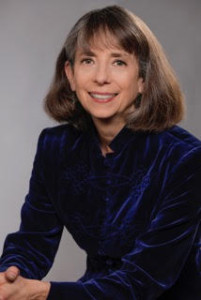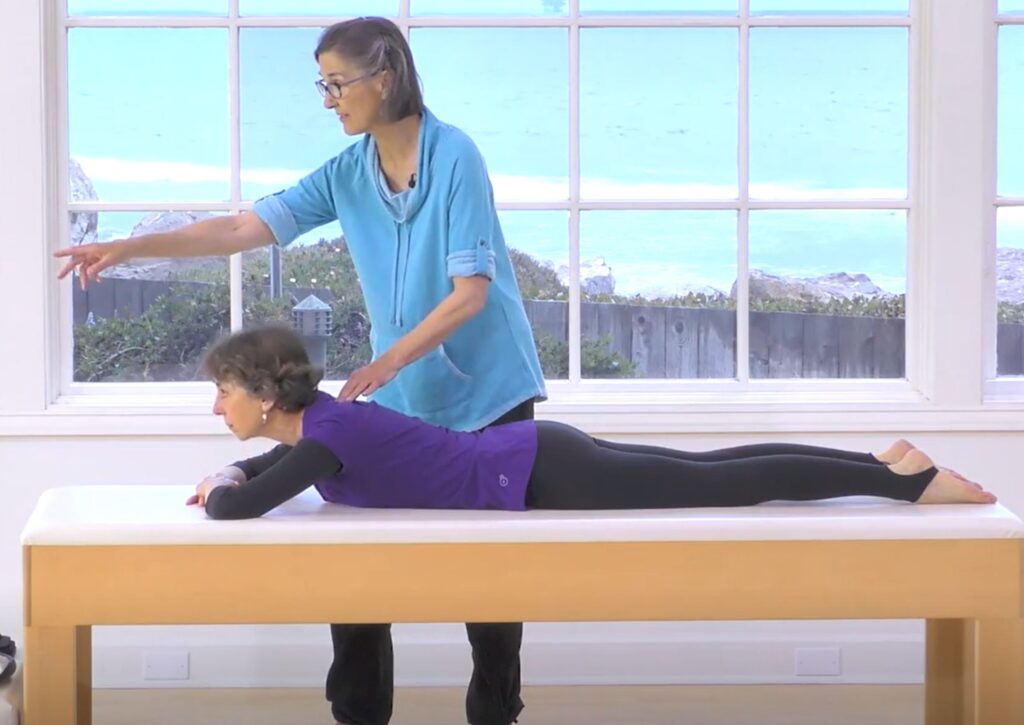Image courtesy of Pilates Anytime
Issue #396
Wednesday, March 29, 2023
Michelle Larsson
Michele Larsson, with Suzanne Gutterson and Debora Kolwey, were the three protégés of Eve Gentry, one of the ‘first generation’ teachers. Michele grew up in Santa Fe, NM and would return from her dance career in San Francisco to visit her mother. One time, her mother mentioned there was a new woman in town, a dancer, who lived up the hill who did something and Michele should go meet her. They did indeed meet, and Eve introduced Michele to Pilates; whenever Michele came back to visit, she would have a lesson with Eve. Later, when Michele ruptured a lumbar disc onstage (and managed to crawl off and get herself, standing all the way, back to Santa Fe) she went straight to Eve, knowing that Eve could heal her. It was then that Michele experienced Eve’s approach to working with injury, what we know as Fundamentals, or Pre-Pilates, and when her apprenticeship with Eve began. She stayed and taught with Eve for many years, until Eve’s retirement and death in 1994.
I learned Pilates from Michele in 1992, apprentice style, before there were teacher training programs. I was introduced to Pilates with only a couple of private sessions; at that point, I had been studying and teaching the work of Somatic pioneers for 15 years. A few people told me my classes were just like Pilates, which I knew they were not, but since I didn’t know Pilates, I went to the only studio in town to check it out so I could articulate the difference. Michele and Joan Briebart, with Eve’s support, had just created the first organization to coalesce the Pilates world – The Institute for the Pilates Method – and needed teachers. She saw I had a similar dance/movement studies background as she did: in particular, we overlapped with the work of Lulu Sweigard whom Michele met when a student at Juilliard. Michele suggested all I needed to do was learn the repertoire. An offer I couldn’t refuse!
Celia Hulton (Michele’s first hired teacher) and I began assisting Michele when she started her teacher-training program (later called Core Dynamics) in 1995. We taught with her for the next 14 years, until she closed that part of the program. Michele’s influence in the Pilates world is enormous; she taught so many people all over the world.
Here are some stories from those years:
One of the things Michele would say is that learning the exercises was equivalent to learning words – but to be a good teacher you have to be fluent in the language of Pilates, you have to be able to make sentences and paragraphs with the words.
Michele always included a section of her teacher training program called “How To See”. We did cover how to do/teach the exercises, of course, but that was the least interesting part of the training for her. And often, her answer to the questions asked was “well, it depends on the body in front of you: the hand can go this way, or that way, depending on their shoulder issues”. It would drive the students nuts, they wanted to be told what was right and what was wrong.
We would start the “How to See” section with me and Michele sitting side by side on the Cadillac, in front of the students gathered in front of us. We would sit there for a bit, saying nothing. Michele would then say, “just look, what do you see?” Of course, they were confused. We would sit there a little longer in silence – and then Michele would give me the eye and we would stand up. And then sit down again. And stand up and sit down once more. We couldn’t help grinning by then… Michele would again ask, “what did you observe?” Michele is close to 6 feet tall; I am shy of 5’3”! Sitting, our torsos are about the same; Michele has a longer neck so her head was a few inches above mine but when you looked at us we presented as the same size. Our arm length, too, is almost the same – Michele’s hand is only slightly longer than mine. But when we stood up, Yikes! It was like a cartoon: I have a long torso and short legs for my height and Michele is all legs!
Then Michele would talk. “You cannot look for the ‘right’ shape for your clients performing the exercises. Ruth and I will not look the same; different dimensions on the reformer will change the shape of the exercise”. We would then demonstrate – the knee stretch series and stomach massage are the ones I remember doing – and she would direct their eyes to how differently we looked doing them. The point was to look beyond the shape of the person in the movement – how bent the knees are, how far back the pelvis is – look instead for the essence of the exercise, look for connected movement. In other words, does the right eyebrow know what the left big toe is up to, is the movement organized and integrated, is it a whole body moving?
Another exercise she would have the students do came from her stepfather who was a painter (visual artist Carl Larsson). She would have someone do the 100’s on the reformer, and everyone else go to the other end of the studio (it was a large room). She would have them take their fingers and pull the outside corners of their eyes until that created a squint and blurred vision. She would then direct them to look at the 100’s when they could only see the general shape but no detail. “Can you see the undercurve, the curved line from the head down the back, pelvis, back of legs to feet?” With blurred vision, you can more easily see where the line of movement is broken, i.e. where the person is disconnected. It was an attempt to lead students out of being so specific, so caught up in details and thereby nitpicking at their clients. Michele used this technique when she couldn’t quite figure out what was going on with her client; it would clarify issues quickly. It can easily be done without the fingers pulling, once you get used to it.
I have many more stories, of course… but this is already longer than your attention span, no doubt!
PS: Michele is still in Santa Fe, fully retired now, having sold Core Dynamics to Kevin Bowen in 2014.

Ruth Alpert has an extensive background of professional training in New York City in classical ballet, beginning with George Balanchine’s School of American Ballet in 1960; modern dance, starting in 1956, including early training at Juilliard and eight
years of Merce Cunningham technique. Ruth graduated from Bard College with a BA in dance in 1973 and has done graduate work at the California Institute of the Arts. She was certified as a practitioner of The Trager ® Approach in 1987, certified in Pilates in 1993, certified in GYROTONIC® Method in 2002, and graduated as an Alexander Technique teacher in 2007.
Ruth has performed with modern and post-modern choreographers. She was an original member of Douglas Dunn & Dancers Company in New York City and while in Austin was a guest with the Deborah Hay Dance Company. Ruth has been Appalachian flatfoot dancing for 42 years. She has taught workshops, danced with Old-Timey string bands, busked (street performed) in various cities in at least 6 states. She currently does foot percussion as a member of The Honeysuckle Possums, a local Santa Barbara all female Americana band.
In 1977, Ruth began to look for a solution to the chronic pain and injury that seemed to be part of a dancer’s life. She began to work with Susan Klein, and studied Release Work (Lulu Sweigard lineage) and the work of Bonnie Bainbridge Cohen of The School for Body-Mind Centering. She was a student of Emilie Conrad’s “Continuum” work for over 8 years. Ruth was trained in pilates by Michele Larsson in 1992, and has been an Associate of Core Dynamics Pilates Teacher Training since 1998.
www.RuthAlpert.com


